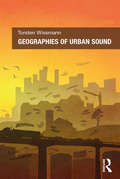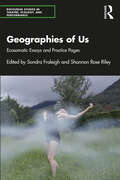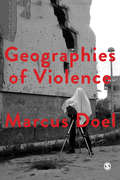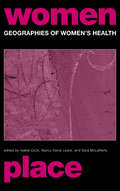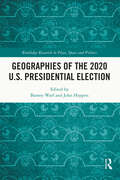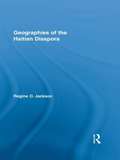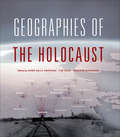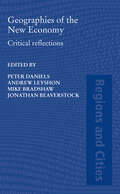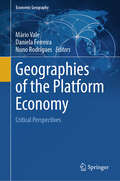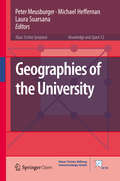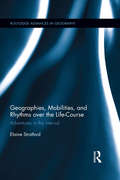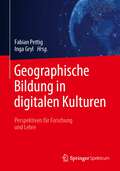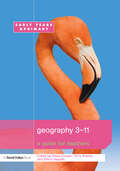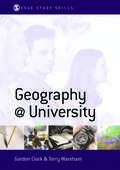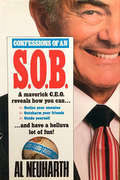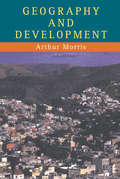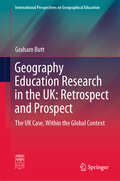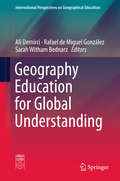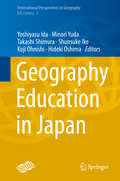- Table View
- List View
Geographies of Urban Sound
by Torsten WissmannTraffic, music, language and nature help to create unique soundscapes that are essential to the place-based character of each city. Taking into account both the urban soundscape and the impacts of sound on the urban dweller, this book examines sound not as a by-product of urban life, but as a fundamental part of the urban experience that is crucial to understanding the city´s sense of place. Illustrated by case studies from Europe and North America, these range from on-site measurements to the construction of audio tours for local tourism, from media analysis of popular culture audio drama to sound-identity and city branding, and from the classification of noise in city planning to a consideration of the complex relationship between sacred sound and the creation of a sense of place. Taking a social geographic perspective, the book focuses on the effects of sounds on the individual and how they influence the ways s/he engages the city as place, especially in their daily routines. In doing so, it uncovers the socio-scientific potential of sound in the urban environment, based on the understanding that sound cannot and must not be seen as detached from the urban landscape, but rather as a constituting element. Sound exists not only ’within the city’: it ’is’ the city.
Geographies of Us: Ecosomatic Essays and Practice Pages (Routledge Studies in Theatre, Ecology, and Performance)
by Sondra Fraleigh Shannon Rose RileyGeographies of Us: Ecosomatic Essays and Practice Pages is the first edited collection in the field of ecosomatics.With a combination of essays and practice pages that provide a variety of scholarly, creative, and experience-based approaches for readers, the book brings together both established and emergent scholars and artists from many diverse backgrounds and covers work rooted in a dozen countries. The essays engage an array of crucial methodologies and critical/theoretical perspectives, including practice-based research in the arts, especially in performance and dance studies, critical theory, ecocriticism, Indigenous knowledges, material feminist critique, quantum field theory, and new phenomenologies. Practice pages are shorter chapters that provide readers a chance to engage creatively with the ideas presented across the collection. This book offers a multidisciplinary perspective that brings together work in performance as research, phenomenology, and dance/movement; this is one of its significant contributions to the area of ecosomatics.The book will be of interest to anyone curious about matters of embodiment, ecology, and the environment, especially artists and students of dance, performance, and somatic movement education who want to learn about ecosomatics and environmental activists who want to learn more about integrating creativity, the arts, and movement into their work.
Geographies of Violence: Killing Space, Killing Time (Society and Space)
by Marcus A DoelWe experience violence all our lives, from that very first scream of birth. It has been industrialized and domesticated. Our culture has not become totally accustomed to violence, but accustomed enough. Perhaps more than enough. Geographies of Violence is a critical human geography of the history of violence, from Ancient Rome and Enlightened wars through to natural disasters, animal slaughter, and genocide. Written with incredible insight and flair, this is a thought-provoking text for human geography students and researchers alike.
Geographies of Violence: Killing Space, Killing Time (Society and Space)
by Marcus A DoelWe experience violence all our lives, from that very first scream of birth. It has been industrialized and domesticated. Our culture has not become totally accustomed to violence, but accustomed enough. Perhaps more than enough. Geographies of Violence is a critical human geography of the history of violence, from Ancient Rome and Enlightened wars through to natural disasters, animal slaughter, and genocide. Written with incredible insight and flair, this is a thought-provoking text for human geography students and researchers alike.
Geographies of Women's Health: Place, Diversity and Difference (Routledge International Studies of Women and Place #Vol. 3)
by Sara McLafferty Isabel Dyck Nancy Davis LewisThis international collection explores the relationships between society, place, gender and health, and how these play out in different parts of the world. The chapters work together in examining the complex layering of social, economic and political relations that frame women's health. The authors demonstrate that women's health needs to be understood 'in place' if gains are to be made in improving women's health and health care.
Geographies of the 2020 U.S. Presidential Election (Routledge Research in Place, Space and Politics)
by Barney Warf John HeppenThis timely, insightful and expert-led volume interprets the 2020 U.S. Presidential Election from a geographical standpoint, with a focus on its spatial dimensions. With contributions from leading thinkers, this book highlights the unique circumstances of the election, including the Covid pandemic and a president who falsely alleged that it was a massive fraud, particularly after he lost. The volume offers an introduction and 12 chapters that examine the run-up to the election, the motivations of Trump supporters, the election results themselves, case studies of the battleground states of Wisconsin and Georgia, and the chaotic aftermath. Accompanied with an engaging plethora of figures providing a visual demonstration of data trends, both national and local case studies are considered throughout this book, as well as right-wing radicalization, the role of Cuban-Americans, race, and threats to American democracy. This book is an ideal study companion for faculty and graduate students in fields including geography and political science, sociology, American studies, media studies and urban planning, as well as those with an interest in U.S. politics more generally.
Geographies of the Haitian Diaspora (Routledge Studies on African and Black Diaspora)
by Jackson Regine O.This book considers the full sweep of Haitian community invention and recreation in a multitude of national territories, with an eye toward the "place" factors that shape the everyday lives of Haitian migrants. Regine O. Jackson brings together an interdisciplinary group of scholars to explore how Haitian communities differ across time and place, as well as how migrants adjust to new economic, political and racial realities. The volume includes descriptive ethnographies of Haitians in 19th century Jamaica, eastern Cuba, Detroit, the Dominican Republic, Guadeloupe, Paris, and Boston, and innovative scholarly work on non-geographic sites of Haitian community building. The most important question addressed here is not whether the places described represent typical or exceptional Haitian diasporic communities, but how, why and to what effect do Haitians in particular places use diaspora as a signifier. By examining the diversity (and sameness) of the Haitian experience in diaspora, Geographies of the Haitian Diaspora asks how we might situate community in view of increased scholarly attention to transnational processes.
Geographies of the Holocaust (The\spatial Humanities Ser.)
by Anne Kelly Knowles Tim Cole Alberto Giordano&“[A] pioneering work . . . Shed[s] light on the historic events surrounding the Holocaust from place, space, and environment-oriented perspectives.&” —Rudi Hartmann, PhD, Geography and Environmental Sciences, University of Colorado This book explores the geographies of the Holocaust at every scale of human experience, from the European continent to the experiences of individual human bodies. Built on six innovative case studies, it brings together historians and geographers to interrogate the places and spaces of the genocide. The cases encompass the landscapes of particular places (the killing zones in the East, deportations from sites in Italy, the camps of Auschwitz, the ghettos of Budapest) and the intimate spaces of bodies on evacuation marches. Geographies of the Holocaust puts forward models and a research agenda for different ways of visualizing and thinking about the Holocaust by examining the spaces and places where it was enacted and experienced. &“An excellent collection of scholarship and a model of interdisciplinary collaboration . . . The volume makes a timely contribution to the ongoing emergence of the spatial humanities and will undoubtedly advance scholarly and popular understandings of the Holocaust.&” —H-HistGeog &“An important work . . . and could be required reading in any number of courses on political geography, GIS, critical theory, biopolitics, genocide, and so forth.&” —Journal of Historical Geography &“Both students and researchers will find this work to be immensely informative and innovative . . . Essential.&” —Choice
Geographies of the New Economy: Critical Reflections (Regions and Cities)
by Andrew Leyshon Jonathan Beaverstock Peter W. Daniels Michael J. BradshawWhat is the 'new economy'? Where is it? How does it differ from the 'old economy'? How does the 'new economy' relate to issues such as the nature of work, social inclusion and exclusion? Geographies of the New Economy explores the meaning of the 'new economy' at the global scale from the perspective of advanced post-socialist and emerging economies. Drawing on evidence from regions around the world, the book debates the efficacy of the widely used concept of the ‘new economy’ and examines its socio-spatial consequences. This book is important reading for policy-makers, academics and students of geography, sociology, urban studies, economics, planning and policy studies.
Geographies of the Platform Economy: Critical Perspectives (Economic Geography)
by Mário Vale Daniela Ferreira Nuno RodriguesThis book provides a wider understanding of the geographies of the platform economy, focusing on the critical perspectives that have emerged on this new economic and digital context. Technological development, particularly the emergence of big data in combination with platforms, additive manufacturing, advanced robotics, machine learning and the internet of things, has created conditions for the appearance of a new economic context predominantly based on new forms of services. This new economic context has been described as the platform economy or platform capitalism. Other designations have also appeared to describe particular consequences of this new phenomena, such as the gig economy or the sharing economy.There is a significant diversity of scientific fields that are studying topics related to the platform economy. Several studies have emerged from different fields, including, but not limited to, geography, economy, sociology, information science, management, marketing, or the humanities. However, geography has become an important field to understand the platform economy given its critical position over the economic, cultural, and social issues that stem from this new economic context. The purpose of this book is to approach these discussions and offer a critical view of the platform economy from the perspective of geography, stemming from the different subfields of the discipline and not restricted to what has been referred to as Digital Geography.This book will appeal to scholars, undergraduate and postgraduate students in the social sciences. It will be particularly relevant to those with research interests in digital geographies and economic geography, economics and business.
Geographies of the University (Knowledge and Space #12)
by Michael Heffernan Peter Meusburger Laura SuarsanaThis open access volume raises awareness of the histories, geographies, and practices of universities and analyzes their role as key actors in today’s global knowledge economy. Universities are centers of research, teaching, and expertise with significant economic, social, and cultural impacts at different geographical scales. Scholars from a variety of disciplines and countries offer original analyses and discussions along five main themes: historical perspectives on the university as a site of knowledge production, cultural encounter, and political interest; institutional perspectives on university governance and the creation of innovative environments; relationships between universities and the city; the impact of universities on national and regional economies and cultures; and the processes of internationalization through student mobility, the creation of education hubs, and global regionalism in higher education.
Geographies, Mobilities, and Rhythms over the Life-Course: Adventures in the Interval (Routledge Advances in Geography)
by Elaine StratfordBy thinking in terms of the geographies of mobilities, we are better able to understand the central importance of movements, rhythms and shifting emplacements over the life-course. This innovative book represents research from a new and flourishing multidisciplinary field that includes, among other things, studies on smart cities, infrastructures and networks; mobile technologies for automated highways or locative media; mobility justice and rights to stay or enter or reside. These activities, cadences and changing attachments to place have profound effects—first upon how we conduct or govern ourselves and each other via many social institutions, and second upon how we constitute the spaces in and through which our lives are experienced. This scholarship also has clear connections to numerous aspects of social and spatial policy and planning.
Geographische Bildung in digitalen Kulturen: Perspektiven für Forschung und Lehre
by Fabian Pettig Inga GrylWelche Herausforderungen für Forschungs- und Lehrkontexte bedingt die tiefgreifende Transformation alltäglicher Räume und Mensch-Umwelt-Verhältnisse in einer Kultur der Digitalität? Und wie lassen sich die hierin liegenden Potenziale für geographische Bildungsprozesse heben?Der vorliegende Band widmet sich diesen übergeordneten Fragestellungen und nimmt ernst, dass die Anforderungen an das Fach Geographie weit über technikfokussierte Ansätze, wie die Anwendung Geographischer Informationssysteme (GIS) im Klassenzimmer, hinausgehen. Ein Ziel sollte die Befähigung der Schüler*innen zum mündigen Medienhandeln in einer digital und medial durchdrungenen Welt sein. Phänomene wie hybride Räume, Smart Cities und Algorithmizität verlangen nach reflektierter und fachlicher Aufarbeitung digitaler Geographien als Bildungsinhalte, um ein geographisches Lernen mit, über und durch digitale Medien, sowie auch eine geographische Bildung in digitalen Medien zu ermöglichen.Dieser Aufgabe nimmt sich der Band aus zehn Perspektiven an, die die deutschsprachige wissenschaftliche Community der Geographiedidaktik gemeinschaftlich entwickelt hat. Sie loten Aufgaben, Handlungsfelder und Gelingensbedingungen geographischer Bildung in digitalen Kulturen aus. Drei Beitragskategorien bieten innerhalb der einzelnen Perspektiven Orientierung: Basiskommentare, die konzeptionelle Grundlagen darstellen; Forschungsbeiträge, die zur theoretischen wie auch empirischen Klärung beitragen und Good Practice-Beispiele, die Einblicke in Hochschul- und Schulpraxis gewähren. Die Perspektiven sind vielfach verwoben, stehen aber stellenweise auch in Spannung zueinander. Allen Beiträgen gemein ist, dass sie nach Wegen suchen, einen kritischen Umgang mit den Möglichkeiten und Herausforderungen des Digitalen wie auch eine emanzipierte Teilhabe in digitalen Kulturen zu etablieren.
Geography 11th Standard - Tamilnadu Board
by Training State Council of Educational ResearchGeography Textbook for the 11th Standard Students, preparing for Tamil Nadu State Board Exam.
Geography 12th Standard - Tamilnadu Board
by Training State Council of Educational ResearchGeography Textbook for the 12th Standard Students, preparing for Tamil Nadu State Board Exam.
Geography 3-11: A Guide for Teachers
by Hilary CooperThe advent of the National Primary Strategy has produced a welcome reminder to teachers of the importance of geography within the primary curriculum. This book aims to encourage this renewed awareness and to support teachers in teaching primary geography in different and exciting ways. It will show that children have an entitlement to learn about geography and this can be achieved in a lively, creative fashion uplifting for both teachers and children. It covers: planning for and assessing progression in learning inclusion ICT and drama indoors, outdoors and beyond. Written in association with the Geographical Association, this book will help both trainee and experienced teachers to integrate geography as an essential part of the primary curriculum.
Geography @ University: Making the Most of Your Geography Degree and Courses (SAGE Study Skills Series)
by Gordon Clark Terry Wareham`This is an essential easy-to-use guide to geography. It is unique in providing not only passive advice but also offering activity based guidance to both potential and current geography undergraduates. Geography at University is wide ranging in its approach offering assistance to all; from those who need help with their dissertation to those writing their curriculum vitae. It is an all encompassing text which offers a fresh and original outlook on geography at degree level' - Lorraine Craig, Royal Geographical Society (with Institute of British Geographers) Geography at University will show students how to do better at university when studying for their degree in geography. It explains how university - and geography at university - differs from the subject at school. At university, students are taught new topics in different ways and will be tested on different abilities - the ability to understand, to explain and to apply knowledge; rather than just on the knowledge itself. This means that students need to learn the subject in new ways: Geography at University shows them exactly how to do that. Being at university is a phase between school and career, this book will show students how university geography builds on school geography and gives them skills employers will be looking for when appointing graduates. Geography at University reviews each of the main methods by which students are taught geography - lectures, tutorial, fieldwork, practicals and projects - and explains what tutors will be trying to do during these sessions so that students can gain the most from teaching. Geography at University explains what tutors are looking for when assessing students works through their essays, examinations, oral presentations anddissertations. There is more to getting a degree than just studying geography. There is much that students can do through a gap year or taking paid or voluntary work to give them an edge when applying for jobs after graduation, and Geography at University explains how they can make the most of these opportunities as well.
Geography Alive! Regions and People, Mapping Lab Lesson Guide with Lesson Masters: Latin America
by Teachers' Curriculum InstituteNIMAC-sourced textbook
Geography Alive! Regions and People, Student Edition
by Teachers' Curriculum InstituteNIMAC-sourced textbook
Geography Alive!®: Interactive Student Notebook
by Teachers' Curriculum InstituteThis Interactive Student Notebook published by Teachers' Curriculum Institute creatively challenges students to use the tools of geography to view, analyze, and understand the world around them.
Geography And Development
by Arthur MorrisFirst published in 1998. Routledge is an imprint of Taylor & Francis, an informa company.
Geography Education Research in the UK: The UK Case, Within the Global Context (International Perspectives on Geographical Education)
by Graham ButtThis book provides a unique assessment of the development of research in geography education and its future prospects, offering a challenging critique of subject-based education research, with particular reference to geography education across a range of different jurisdictions. It covers a range of topics, including the changing role of research in geography education; the relationship between education research and professional practice, with special reference to geography education research; the place of academic subject knowledge in geography education research; critiques of the functions of research in geography education; and the key issues for education policy and policymakers concerning educational research at national and international levels.Importantly, in a period marked by radical change for education research and researchers, the book offers a timely appraisal of possible ways forward for geography education research. Addressing the needs of academics, research students, policymakers, and education practitioners who undertake, use or shape the future of research in geography education, it comprehensively explores the forces that have driven the development of geography education research and pedagogy. Further, by positioning its analysis in the context of education policy debates in the UK, and further afield, it assesses the role and function of research in education, and offers an outlook on its future. This book is essential reading for all those who wish to understand the sporadic and increasingly uncertain development of subject-based research in education
Geography Education for Global Understanding (International Perspectives On Geographical Education Ser.)
by Sarah Witham Bednarz Ali Demirci Rafael de Miguel GonzálezThis book presents the core concepts of geographical education as a means of understanding global issues from a spatial perspective. It treats education, supported by high standards, approaches, methodologies, and resources, as essential in exploring the interactions of the world’s human and environmental systems at local, regional, and global scales embedded in the nature of the discipline of geography. It covers topics such as climate change, sustainable development goals, geopolitics in an uncertain world, global crisis, and population flows, which are of great interest to geography researchers and social sciences educators who want to explore the complexity of contemporary societies.Highly respected scholars in geography education answer questions on key topics and explain how global understanding is considered in K-12 education in significant countries around the globe. The book discusses factors such as the Internet, social media, virtual globes and other technological developments that provide insights into and visualization – in real time – of the intensity of relationships between different countries and regions of the earth. It also examines how this does not always lead to empathy with other political, cultural, social and religious values: terrorism threats and armed conflicts are also essential features of the global world. This book opens the dialogue for global understanding as a great opportunity for teachers, educators, scholars and policy makers to better equip students and future citizens to deal with global issues.
Geography Education in Japan
by Yoshiyasu Ida Minori Yuda Takashi Shimura Shunsuke Ike Koji Ohnishi Hideki OshimaIn a globalized market where the emerging workforce will increasingly travel within their nations and abroad for work opportunities, it is valuable to learn about the international education system and practices, to assess the competition. For example, annual comparison of student performance is measured across math and science subjects globally. What is not well known is how geography educational systems compare around the world and how student success in this subject translates to learning in other courses or employment after graduation. The importance of geography in our personal, professional, and civic lives is transparent when one considers how finding one's way with a map, understanding of world cultures, or identifying spatial patterns of disease spread might influence the decisions we make. Written for a global audience, this is the first English publication on geography education in Japan, addressing some fundamental questions. What is the nature of the geography educational systems in Japan? How does the focus on content and skills in Japanese schools differ from that in other countries? This book includes 25 authors from diverse geography instruction and research experiences, making it an authoritative publication on Japan's geography education system. The contribution of this book to the larger geography educational community is sharing the key strengths, concerns, and future of this school subject in English, where previously most publications were in Japanese. It will be a useful source for researchers and teachers to understand Japan's evolving geography instruction in the past, present, and future. The 21 chapters are organized into themes, beginning with an overview of the geography education system in Japan, followed by chapters that deal with regional geography and fieldwork, teacher training, geography education's contributions to society, and a comparative study of geography education across multiple countries. The book ends with a vision of geography education in the future.
